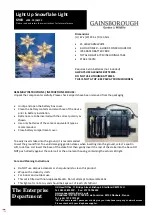
EN
SAFETY REGULATIONS
There is a risk to life if these safety
instructions are not observed!
• The personal protective equipment
(PPE) may no longer be used even in
the case of very minor faults.
• Damaged, fall-stressed or dubious
personal protective equipment or
safety devices must be immediately
withdrawn and not used. The equip-
ment may only be inspected by an
expert in compliance with DGUV
(German Social Accident Insurance)
principle 312-906, by BORNACK or by a
workshop authorised in writing by
BORNACK. This must be documented
in the test card.
• Independent modifications or repairs
are not allowed.
• Rope protection is part of the personal
fall prevention equipment and should
be assigned to a specific person.
• The personal protective equipment
may only be used by qualified staff
that are familiar with the material.
They must be proficient in handling
the personal protective equipment
and must have been briefed about the
possible risks associated with its use.
• In accordance with the accident
prevention guidelines (UVV), the users
of personal protective equipment
against falls (Category III) must attend
a theoretical training course and a
practical training course. Make use of
the training competence of the
BORNACK training centres: info@
bornack.de
• Clothing and shoes must be suitable
for the task at hand and the weather
conditions.
• Only use if fully fit and healthy.
• Health impairments can jeopardise
the safety of the user when working at
heights or depths.
• If this PPE is used as an arrester system
(free fall is possible), only full body
harnesses that comply with EN 361
may be used.
• Calculation of the possible fall path if
all necessary PPE components are used
correctly: (if necessary braking path
HSG) + surplus lanyard (situation-
dependent) + braking path energy
absorber (max. 1.75 m) + height of
D-ring (1.5 m) + safety reserve 1.0 m.
• Before use, ensure adequate clearance
below the user to prevent impact on a
protruding object or the ground.
• Protect personal protective equipment
during storing, use and transportation
against the effects of heat (e.g.
welding flames or sparks, burning
cigarettes) and chemicals (e.g. acids,
alkalis, oils) and mechanical impact
(e.g. sharp edges).














































